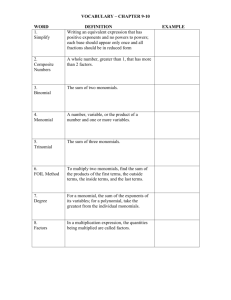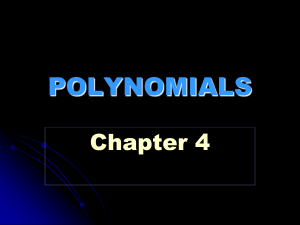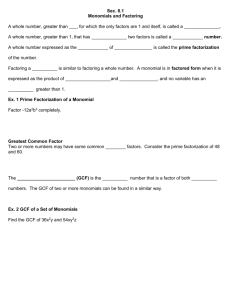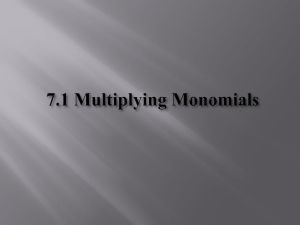Depth and minimal number of generators of square free monomial ideals
advertisement
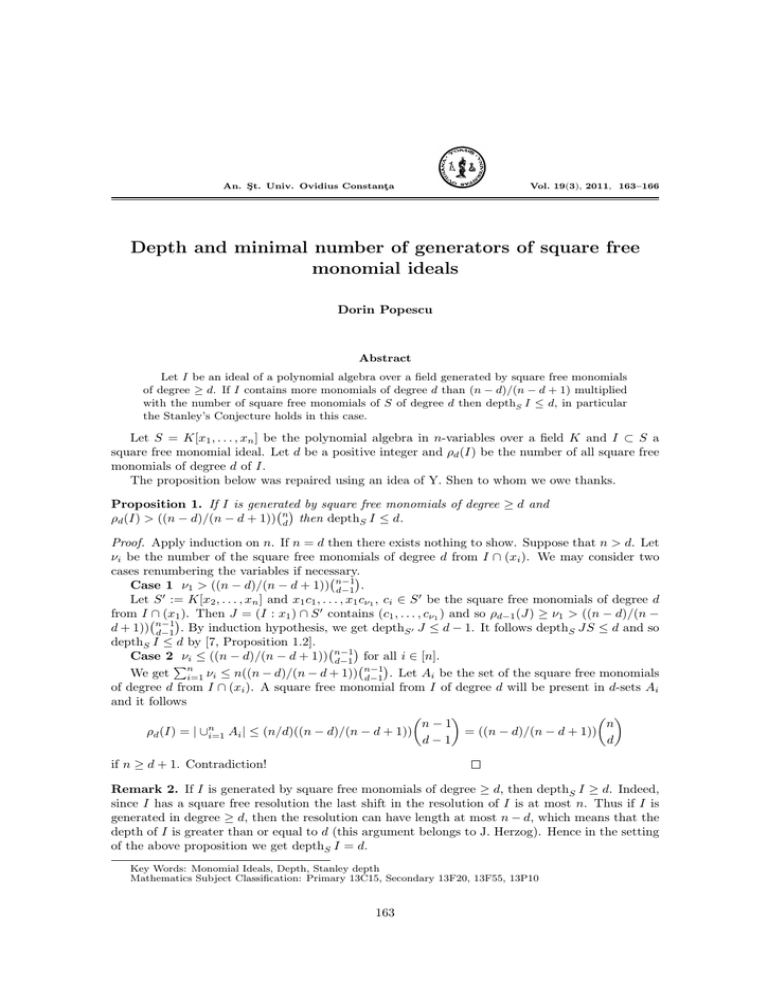
An. Şt. Univ. Ovidius Constanţa
Vol. 19(3), 2011, 163–166
Depth and minimal number of generators of square free
monomial ideals
Dorin Popescu
Abstract
Let I be an ideal of a polynomial algebra over a field generated by square free monomials
of degree ≥ d. If I contains more monomials of degree d than (n − d)/(n − d + 1) multiplied
with the number of square free monomials of S of degree d then depthS I ≤ d, in particular
the Stanley’s Conjecture holds in this case.
Let S = K[x1 , . . . , xn ] be the polynomial algebra in n-variables over a field K and I ⊂ S a
square free monomial ideal. Let d be a positive integer and ρd (I) be the number of all square free
monomials of degree d of I.
The proposition below was repaired using an idea of Y. Shen to whom we owe thanks.
Proposition 1. If I is generated
( ) by square free monomials of degree ≥ d and
ρd (I) > ((n − d)/(n − d + 1)) nd then depthS I ≤ d.
Proof. Apply induction on n. If n = d then there exists nothing to show. Suppose that n > d. Let
νi be the number of the square free monomials of degree d from I ∩ (xi ). We may consider two
cases renumbering the variables if necessary.
(
)
Case 1 ν1 > ((n − d)/(n − d + 1)) n−1
d−1 .
Let S ′ := K[x2 , . . . , xn ] and x1 c1 , . . . , x1 cν1 , ci ∈ S ′ be the square free monomials of degree d
from I (∩ (x)1 ). Then J = (I : x1 ) ∩ S ′ contains (c1 , . . . , cν1 ) and so ρd−1 (J) ≥ ν1 > ((n − d)/(n −
d + 1)) n−1
d−1 . By induction hypothesis, we get depthS ′ J ≤ d − 1. It follows depthS JS ≤ d and so
depthS I ≤ d by [7, Proposition 1.2]. (
)
Case 2 νi ≤ ((n − d)/(n − d + 1)) n−1
for all i ∈ [n].
d−1
(n−1)
∑n
We get i=1 νi ≤ n((n − d)/(n − d + 1)) d−1 . Let Ai be the set of the square free monomials
of degree d from I ∩ (xi ). A square free monomial from I of degree d will be present in d-sets Ai
and it follows
(
)
( )
n−1
n
ρd (I) = | ∪ni=1 Ai | ≤ (n/d)((n − d)/(n − d + 1))
= ((n − d)/(n − d + 1))
d−1
d
if n ≥ d + 1. Contradiction!
Remark 2. If I is generated by square free monomials of degree ≥ d, then depthS I ≥ d. Indeed,
since I has a square free resolution the last shift in the resolution of I is at most n. Thus if I is
generated in degree ≥ d, then the resolution can have length at most n − d, which means that the
depth of I is greater than or equal to d (this argument belongs to J. Herzog). Hence in the setting
of the above proposition we get depthS I = d.
Key Words: Monomial Ideals, Depth, Stanley depth
Mathematics Subject Classification: Primary 13C15, Secondary 13F20, 13F55, 13P10
163
Corollary 3. Let I (be)an ideal generated by µ(I) square free monomials of degree d. If µ(I) >
((n − d)/(n − d + 1)) nd then depthS I = d.
()
Example 4. Let I = (x1 x2 , x2 x3 ) ⊂ S := K[x1 , x2 , x3 ]. Then d = 2 and µ(I) = 2 > (1/2) 32 . It
follows that depthS I = 2 by the above corollary.
Example 5. Let I = (x1 x2 , x1 x3 , x1 x4 , x2 x3 , x2 x5 , x3(x)4 , x3 x5 , x4 x5 ) ⊂
S := K[x1 , . . . , x5 ]. Then d = 2 and µ(I) = 8 > (3/4) 52 and so depthS I = 2.
( n )
Next lemma presents a nice class of square free monomial ideals I with µ(I) = d+1
≤ ((n −
(n)
d)/(n − d + 1)) d but depthS I = d. We suppose that n ≥ 3. Let w be the only square free
monomial of degree n of S, that is w = Πnj=1 xi . Set fi = w/(xi xi+1 ) for 1 ≤ i < n, fn = w/(x1 xn )
and let Ln := (f1 , . . . , fn−1 ), In := (L, fn ) be(ideals
) of S generated in degree d = n − 2. We will
n
see that depthS In = n − 2 even µ(In ) = n = d+1
.
Lemma 6. Then depthS Ln = n − 1 and depthS In = n − 2.
Proof. Apply induction on n ≥ 3. If n = 3 then L3 = (x3 , x1 ), I3 = (x1 , x2 , x3 ) and the result is
trivial. Assume that n > 3. Note that (Ln : xn ) = Ln−1 S = (In : xn ) because fn , fn−1 ∈ (Ln : xn ).
We have
Ln = (Ln : xn ) ∩ (xn , Ln ) = (Ln−1 S) ∩ (xn , fn−1 ),
In = (In : xn ) ∩ (xn , In ) = (Ln−1 S) ∩ (xn , fn−1 , fn ) = (Ln−1 S) ∩ (xn , u) ∩ (x1 , xn−1 , xn ),
where u = w/(x1 xn−1 xn ). But (x1 , xn−1 ) is a minimal prime ideal of Ln−1 S and so we may remove
(x1 , xn−1 , xn ) above, that is In = (Ln−1 S) ∩ (xn , u). On the other hand, (Ln−1 S) + (xn , u) =
(xn , In−1 ) and (Ln−1 S) + (xn , fn−1 ) = (xn , Ln−1 )S because fn−1 ∈ Ln−1 S. We have the following
exact sequences
0 → S/Ln → S/Ln−1 S ⊕ S/(xn , fn−1 ) → S/(xn , Ln−1 S) → 0,
0 → S/In → S/Ln−1 S ⊕ S/(xn , u) → S/(xn , In−1 S) → 0.
By induction hypothesis depth Ln−1 = n−2 and depth In−1 = n−3 and so depthS S/(xn , Ln−1 S) =
n − 3, depthS S/(xn , In−1 S) = n − 4. As depthS S/(xn , fn−1 ) = depthS S/(xn , u) = n − 2, it
follows depthS S/Ln = n − 2, depthS S/In = n − 3 by the Depth Lemma applied to the above
exact sequences.
Now, let I be an arbitrary square free monomial ideal and PI the poset given by all square free
monomials of I (a finite set) with the order given by the divisibility. Let P be a partition of PI in
intervals [u, v] = {w ∈ PI : u|w, w|v}, let us say PI = ∪i [ui , vi ], the union being disjoint. Define
sdepth P = mini deg vi and sdepthS I = maxP sdepth P, where P runs in the set of all partitions of
PI . This is the so called the Stanley depth of I, in fact this is an equivalent definition given in a
general form by [1].
For instance, in Example 4, we have PI = {x1 x2 , x2 x3 , x1 x2 x3 } and we may take P : PI =
[x1 x2 , x1 x2 x3 ] ∪ [x2 x3 , x2 x3 ] with sdepthS P = 2. Moreover, it is clear that sdepthS I = 2.
( n )
Remark 7. If I is generated by µ(I) > d+1
square free monomials of degree d then sdepthS I =
(n)
( n )
d. Since ((n − d)/(n − d + 1)) d ≥ d+1 , the Proposition 1 says that in a weaker case case
depthS I ≤ sdepthS I, which was in general conjectured by Stanley [8]. Stanley’s Conjecture holds
for intersections of four monomial prime ideals of S by [2] and [4] and for square free monomial
ideals of K[x1 , . . . , x5 ] by [3] (a short exposition on this subject is (given
) in [5]). It is worth to
n
mention that Proposition 1 holds in the stronger case when µ(I) > d+1
(see [6]), but the proof
is much more complicated and the easy proof given in the present case has its importance.
164
In the Example 5 we have PI = [x1 x2 , x1 x2 x4 ]∪[x1 x3 , x1 x3 x5 ]∪[x1 x4 , x1 x4 x5 ]∪[x2 x3 , x1 x2 x3 ]∪
[x3 x4 , x1 x3 x4 ] ∪ [x3 x5 , x3 x4 x5 ] ∪ [x4 x5 , x2 x4 x5 ] ∪ [x2 x3 x4 , x2 x3 x4 ] ∩ [x2 x3 x5 , x2 x3 x5 ] ∪ (∪α [α, α]),
where α runs in the set of square free monomials of I of degree 4, 5. It follows that sdepthS I = 3.
But as we know depthS I = 2.
Acknowledgment. The support from the CNCSIS grant PN II-542/2009 of Romanian Ministry
of Education, Research and Inovation is gratefully acknowledged.
References
[1] J. Herzog, M. Vladoiu, X. Zheng, How to compute the Stanley depth of a monomial ideal, J.
Algebra, 322 (2009), 3151-3169.
[2] A. Popescu, Special Stanley Decompositions, Bull. Math. Soc. Sc. Math. Roumanie, 53(101),
no 4 (2010), arXiv:AC/1008.3680.
[3] D. Popescu, An inequality between depth and Stanley depth, Bull. Math. Soc. Sc. Math.
Roumanie 52(100), (2009), 377-382, arXiv:AC/0905.4597v2.
[4] D. Popescu, Stanley conjecture on intersections of four monomial prime ideals,
arXiv.AC/1009.5646.
[5] D. Popescu, Bounds of Stanley depth, An. St. Univ. Ovidius. Constanta, 19(2),(2011), 187-194.
[6] D. Popescu, Depth of factors of square free monomial ideals, Preprint, 2011.
[7] A. Rauf, Depth and Stanley depth of multigraded modules, Comm. Algebra, 38 (2010),773-784.
[8] R. P. Stanley, Linear Diophantine equations and local cohomology, Invent. Math. 68 (1982)
175-193.
165
Institute of Mathematics ”Simion Stoilow”, Research unit 5, University of
Bucharest,
P.O.Box 1-764, Bucharest 014700,
Romania e-mail: dorin.popescu@imar.ro
166


